
A shoe is an item of footwear intended to protect and comfort the human foot. Shoes are also used as an item of decoration and fashion. The design of shoes has varied enormously through time and from culture to culture, with form originally being tied to function. Though the human foot can adapt to varied terrains and climate conditions, it is still vulnerable to environmental hazards such as sharp rocks and temperature extremes, which shoes protect against. Some shoes are worn as safety equipment, such as steel-toe boots which are required footwear at industrial worksites.

Footwear refers to garments worn on the feet, which typically serves the purpose of protection against adversities of the environment such as wear from ground textures and temperature. Footwear in the manner of shoes therefore primarily serves the purpose to ease locomotion and prevent injuries. Footwear can also be used for fashion and adornment as well as to indicate the status or rank of the person within a social structure. Socks and other hosiery are typically worn additionally between the feet and other footwear for further comfort and relief. Cultures have different customs regarding footwear. These include not using any in some situations, usually bearing a symbolic meaning. This can however also be imposed on specific individuals to place them at a practical disadvantage against shod people, if they are excluded from having footwear available or are prohibited from using any. This usually takes place in situations of captivity, such as imprisonment or slavery, where the groups are among other things distinctly divided by whether or whether not footwear is being worn.

Gothic fashion is a clothing style marked by dark, mysterious, antiquated, homogenous, and often genderless features. It is worn by members of the Goth subculture. Dress, typical gothic fashion includes dyed black hair, exotic hairstyles, dark lipstick and dark clothing. Both male and female goths can wear dark eyeliner, dark nail polish and lipstick - most often black, dramatic makeup and sometimes fishnets. Male goths use cosmetics at a higher rate than other men. Styles are often borrowed from the punk fashion Victorians and Elizabethans. Goth fashion is sometimes confused with heavy metal fashion and emo fashion.

Fetish fashion is any style or appearance in the form of a type of clothing or accessory, created to be extreme or provocative in a fetishistic manner. These styles are by definition not worn by the majority of people; if everyone wears an item, it cannot have fetishistic, special nature. They are usually made of materials such as leather, latex or synthetic rubber or plastic, nylon, PVC, spandex, fishnet, and stainless steel. Some fetish fashion items include: stiletto heel shoes and boots, hobble skirts, corsets, collars, full-body latex catsuits, stockings, miniskirt, crotchless underwear, diapers, garters, locks, rings, zippers, eyewear, handcuffs, and stylized costumes based on more traditional outfits, such as wedding dresses that are almost completely see-through lace, or lingerie for men.

Punk fashion is the clothing, hairstyles, cosmetics, jewellery, and body modifications of the punk counterculture. Punk fashion varies widely, ranging from Vivienne Westwood designs to styles modeled on bands like The Exploited to the dressed-down look of North American hardcore. The distinct social dress of other subcultures and art movements, including glam rock, skinheads, rude boys, greasers, and mods have influenced punk fashion. Punk fashion has likewise influenced the styles of these groups, as well as those of popular culture. Many punks use clothing as a way of making a statement.

Dr. Martens, also commonly known as Doc Martens, Docs or DMs, is a British footwear and clothing brand, headquartered in Wollaston in the Wellingborough district of Northamptonshire, England. Although famous for its footwear, Dr. Martens also makes a range of accessories – such as shoe care products, clothing, and bags. The footwear is distinguished by its air-cushioned sole, upper shape, welted construction and yellow stitching. Dr Martens' design studio is in Camden Town, London; the manufacturing is in the UK, China, and Thailand. The company is listed on the London Stock Exchange and is a constituent of the FTSE 250 Index.
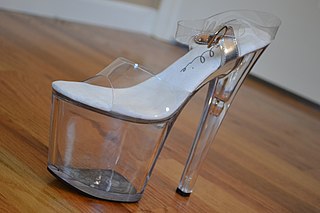
Platform shoes are shoes, boots, or sandals with an obvious thick sole, usually in the range of 3–10 cm (1–4 in). Platform shoes may also be high heels, in which case the heel is raised significantly higher than the ball of the foot. Extreme heights, of both the sole and heel, can be found in fetish footwear such as ballet boots, where the sole may be up to 20 cm (8 in) high and the heels up to 40 cm (16 in) or more. The sole of a platform shoe can have a continuous uniform thickness, have a wedge, a separate block or a stiletto heel. Raising the ankle increases the risk of a sprained ankle.

Greasers are a youth subculture that emerged in the 1950s and early 1960s from predominantly working class and lower-class teenagers and young adults in the United States. The subculture remained prominent into the mid-1960s and was particularly embraced by certain ethnic groups in urban areas, particularly Italian Americans and Latino Americans.
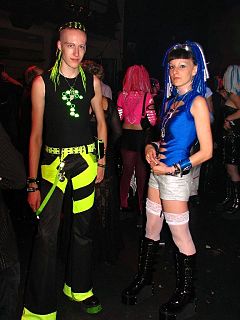
Cybergoth is a subculture that derives from elements of goth, raver, rivethead and cyberpunk fashion.
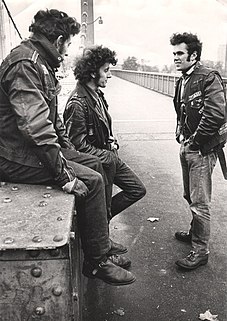
Rockers, leather boys, Ton-up boys, and possibly café racers are members of a biker subculture that originated in the United Kingdom during the 1950s. It was mainly centered on British motorcycles and rock 'n' roll music. By 1965, the term greaser had also been introduced to the UK, and, since then, the terms greaser and rocker have become synonymous within the British Isles although used differently in North America and elsewhere. Rockers were also derisively known as Coffee Bar Cowboys. Their Japanese counterpart was called the Kaminari-Zoku.

An Australian work boot is a style of work shoe, typically constructed with a leather upper bound together with elastic sides and pull tabs on the front and back of the boot. The shoe lacks a tongue, and laces, and often contains a steel toe cap for occupational health and safety reasons. When the shoe contains a steel cap they are often known as "safety boots" or "steel toe boots". The boots generally lack an inner lining. The sole is generally polyurethane and the leather uppers are treated to be resistant to hot water, fats and mild alkaline and acid solutions.
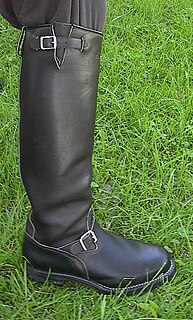
Engineer boots, also known as engineer's boots or engineering boots, are an American type of traditional leather work-boots. Their lace-less, rugged construction made them popular among motorcycle riders. Originally developed in the 1930s for firemen working on steam locomotives, the boots gained substantial popularity in the post–World War II era during a growing motorcycling culture. They became popular symbols of teenage rebellion in the 1950s and a common component of greaser wear. They were later adopted by skinheads and punks in the 1970s. By the 2010s, engineer boots were being popularly worn for fashion purposes, especially by non-traditional customers such as women, young urban professionals, and hipsters.

Fashion in the 1990s was defined by a return to minimalist fashion, in contrast to the more elaborate and flashy trends of the 1980s. One notable shift was the mainstream adoption of tattoos, body piercings aside from ear piercing and, to a much lesser extent, other forms of body modification such as branding.

Fashion of the 1980s placed heavy emphasis on cheap clothes and fashion accessories and very big poofy hair. Apparel tended to be very bright and vivid in appearance. Punk fashion began as a reaction against both the hippie movement of the past decades and the materialist values of the current decade. The first half of the decade was relatively tame in comparison to the second half, which is when the iconic 1980s color scheme had come into popularity.
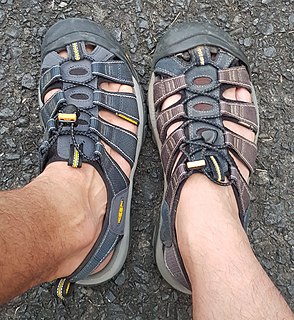
Keen is an American footwear and accessories company based in Portland, Oregon. It was founded in 2003 by Martin Keen and Rory Fuerst. The company's products are sold in retail locations throughout the domestic American market and also are distributed worldwide.
Merrell is an American manufacturing company of footwear products. It was founded by Clark Matis, Randy Merrell, and John Schweizer in 1981 as a maker of high-performance hiking boots. Since 1997, the company has been a wholly owned subsidiary of shoe industry giant Wolverine World Wide. The company recorded total sales of footwear and clothing of nearly $500 million in 2010.

Trash and Vaudeville is a store located at 96 East 7th Street between Avenue A and First Avenue in East Village in Manhattan, New York. The store is associated with the clothing styles of punk rock and various other counter culture movements, and has been a leading source of fashion inspiration since its inception by owner and founder Ray Goodman in 1975.
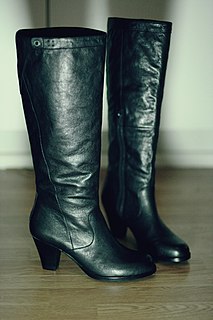
A fashion boot is a boot worn for reasons of style or fashion. The term is usually applied to women's boots. Fashion boots come in a wide variety of styles, from ankle to thigh-length, and are used for casual, formal, and business attire. Although boots were a popular style of women's footwear in the 19th century, they were not recognized as a high fashion item until the 1960s. They became widely popular in the 1970s and have remained a staple of women's winter wardrobes since then.

The 2010s were defined by hipster fashion, athleisure, a revival of austerity-era period pieces and alternative fashions, swag-inspired outfits, 1980s-style neon streetwear, and unisex 1990s-style elements influenced by grunge and skater fashions. The later years of the decade witnessed the growing importance in the western world of social media influencers paid to promote fast fashion brands on Pinterest and Instagram.

Lewis Leathers is a brand name of the oldest British motorcycle clothing company. D. Lewis Ltd, manufacturer of leather jackets which was established in the late 19th century.


















